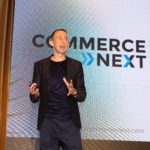Some would say that we’re going through a “retail apocalypse.” Others say, “That’s a little dramatic,” and that the only retailers struggling to survive are those failing to engage in forward-thinking ecommerce and marketing innovation. In order to thrive, brands must implement technology and a digital media strategy that results in seamless experiences across channels. Frictionless omnichannel experiences, while perhaps a buzzy phrase from seasons past, still proves a major obstacle—and a major opportunity—for most retailers.
At CommerceNext 2019, Conor Ryan (Co-founder and CIO at StitcherAds) and Kevin St. John (Industry Manager at Facebook) outlined how retailers can adopt Facebook’s retail-focused tools to reduce friction throughout the customer journey. They dove deep into the waters of innovative, automated digital media solutions retailers can use to amplify ad creative and drive omnichannel results, across online and stores.
The friction problem.
The retailer advertising space continuously advances its capabilities to enhance shopping experiences through digital connectivity. Yet, despite the ecommerce revolution, brick-and-mortar retailers must also optimize for in store sales. St. John explains that with the majority of purchases still occurring in store, brick-and-mortar retailers need a digital media and social ad strategy that allows for targeting and measuring against in store objectives. Retailers are adapting to the larger macro trend of shifting ads from Feeds to Stories, while also trying to understand who is buying in store and how social contributes to incremental conversions.
Aside from the omnichannel conundrum, the expansion of social advertising opportunities also leads to limitless customer choices and, thus, more possibilities for friction throughout the customer journey (like poor search experiences, confusing user experiences, slow load times, etc.).
Knowing both store optimization and omnichannel tactics are necessities for retailers, Ryan and St. John consider the biggest barriers to creating these frictionless experiences and how Facebook solves for them.
Marketing innovation to reduce friction.
A retailer’s goal is simple: give customers the most efficient way to find what they want and buy it immediately, without anything getting in their way. A successful digital media omnichannel program utilizing dynamic ads does just that—helps customers find what they want quicker than ever by pulling in data that shows current price, closest store locations and up-to-date stock in their desired location.
But, numerous things can cause hiccups when creating this customer journey. According to St. John and Ryan, those things boil down to two fundamental issues in approach that can be solved with marketing innovation: lacking proper infrastructure and resources to support cross-channel and digital media efforts; and insufficient online to offline personalization.
Facebook continuously tries to reduce friction across its entire product, with the personalized shopping experience now at the forefront of those efforts. StitcherAds enables brands to then take maximum advantage of Facebook and Instagram’s advertising tools by providing the resources to run strategic campaigns and cut through the confusion when taking a marketing program from online to offline.
Setting up proper infrastructure.
With the help of specialized marketers and Facebook partners, like StitcherAds, brands can unlock a number of infrastructure and resource related issues around data that inhibit successful omnichannel practices. Often, brands need to engage bespoke technological integrations to accommodate custom requirements around organizing data (product, CRM and inventory), and they are usually all stored in different places. If the data isn’t then put together and structured properly, it won’t effectively power omnichannel efforts.
St. John points out two things retailers should always think about when setting up their omnichannel infrastructure with the end goal of reducing friction:
- Integrating local inventory feed to let consumers know where the product can be found, if it is in stock and what the current price is.
- Using automated tools to understand what about their ad creative works and doesn’t work to convert. Many brands jump too quickly into trying to build authenticity through Facebook and Instagram Stories, which won’t move the needle over time if the retailer doesn’t continuously analyze their ad landscape.
Going deeper with dynamic creative.
After proper set up, brands and retailers can take Facebook’s tools one step further than just pumping out static targeted ads or stories. Brands utilize Facebook to first find people who will love the brand, then personalize the ads served to reduce friction pre and post purchase. The ideal ad gives as much information to the consumer pre purchase as possible. Dynamic ads offer the most options for populating personalized elements, including: nearest store and current price, user generated content (authentic influencer content, unboxing stories, etc.), star ratings (for highly rated products) and purchase options (free delivery, by-one-get-one, etc.).
Facebook further reduces friction during post purchase by meeting the consumer where they first found the product and providing status updates, customer service and responses to the ever-growing demand for rapid fulfillment.
Reporting better.
Using dynamic creative that addresses the omnichannel shopping experience can vastly expand retailers’ ability to measure success. Dynamic creative allows for more data touchpoints and improved ways of tracking attribution and multi-touch attribution. Retailers can also measure the true incremental impact of campaigns and individual creative using Facebook’s lift test.
Making the most out of your resources.
To find true incremental lift via Facebook and Instagram, retailers can leverage resources they already built, engage a Facebook partner with the strategic knowhow and stick to a comprehensive test-and-learn plan.
Within Facebook’s partner ecosystem lives StitcherAds. As a seasoned ad expert in the social media realm, Ryan finds the most robust and successful creative programs come from repurposed assets. Digital circulars are the easiest place to start, as most retailers already build creative for mobile and understand that circulars perform well. Retailers and brands can easily take existing assets, including print circulars and catalogs, and leverage them to amplify social campaigns and get more bang for their buck. With that same proper infrastructure, a partner like StitcherAds can help match features of a print circular to locations, inventory and promotions in store, then layer on the digital personalization through targeting. This creates a more economic and much faster digital test-and-learn environment for retailers.
When it comes to test-and-learn plans, Facebook recommends implementing a full year-long learning agenda. The goals remain the same: test store traffic objectives and optimize for store sales and store visits against digital media strategies. But, the plan should allow for brands to build momentum and build in existing technology partners to power smarter ads (e.g. recommendation engines, loyalty programming, etc.).
Reducing friction at every stage of the customer journey is no doubt complex, but it’s now more doable with the robust, automated tools of Facebook and Instagram. Retailers need to focus on marketing innovation, constantly optimizing digital media for the omnichannel customer and include offline results. Even with constrained resources, retailers and brands now have the opportunity to design advanced test-and-learn cycles while leveraging creative automation and dynamic advertising for incremental success. Frictionless experiences are possible—who will master them first?
You can view the full session on our Youtube channel here.
To get more insights like these, apply to attend CommerceNext 2020 today. The conference will take place on July 28-29th in NYC. Inc.com named CommerceNext one of “Top 5 ECommerce Conferences for 2019 and 2020.” We hope you’ll join us this summer.
Related Posts
-
Balancing Brand and Performance Marketing At Scale
It seems that these days, every marketing team’s goal is…
-
How Retailers Are Investing In Digital Customer Experience
Time is the most precious resource. Within our twenty-four hour…
-
How Walmart Adapts Customer Experience for the Digital Shopper
Walmart.com is anything but basic. The retailer is perhaps best…




